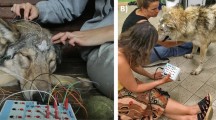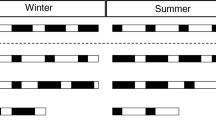Abstract
Insight into the function of sleep may be gained by studying animals in the ecological context in which sleep evolved. Until recently, technological constraints prevented electroencephalogram (EEG) studies of animals sleeping in the wild. However, the recent development of a small recorder (Neurologger 2) that animals can carry on their head permitted the first recordings of sleep in nature. To facilitate sleep studies in the field and to improve the welfare of experimental animals, herein, we test the feasibility of using minimally invasive surface and subcutaneous electrodes to record the EEG in barn owls. The EEG and behaviour of four adult owls in captivity and of four chicks in a nest box in the field were recorded. We scored a 24-h period for each adult bird for wakefulness, slow-wave sleep (SWS), and rapid-eye movement (REM) sleep using 4 s epochs. Although the quality and stability of the EEG signals recorded via subcutaneous electrodes were higher when compared to surface electrodes, the owls’ state was readily identifiable using either electrode type. On average, the four adult owls spent 13.28 h awake, 9.64 h in SWS, and 1.05 h in REM sleep. We demonstrate that minimally invasive methods can be used to measure EEG-defined wakefulness, SWS, and REM sleep in owls and probably other animals.





Similar content being viewed by others
Abbreviations
- EEG:
-
Electroencephalogram
- SWS:
-
Slow-wave sleep
- TST:
-
Total sleep time
- REM:
-
Rapid-eye movement
References
Allison T (1972) Comparative and evolutionary aspects of sleep. In: Chase MH (ed) Perspectives in the brain sciences: the sleeping brain. Brain Information Service, Los Angeles, pp 1–57
Bell FR, Itabisashi T (1973) The electroencephalogram of sheep and goats with special reference to rumination. Physiol Behav 11:503–514
Berger RJ, Walker JM (1972) Sleep in the burrowing owl (Speotyto cunicularia hypugaea). Behav Biol 7:183–194
Campbell IG, Feinberg I (2009) Longitudinal trajectories of non-rapid eye movement delta and theta EEG as indicators of adolescent brain maturation. Proc Natl Acad Sci 106:5177–5180
Cooper RG, Horbańczuk JO, Villegas-Vizcaíno R, Kennou Sebei S, Faki Mohammed AE, Mahrose KMA (2010) Wild ostrich (Struthio camelus) ecology and physiology. Trop Anim Health Prod 42:363–373
Erkert HG (1969) Die Bedeutung des Lichtsinnes für Aktivität und Raumorientierung der Schleiereule (Tyto alba guttata Brehm). Z Vergl Physiol 64:37–70
Galvão de Moura Filho AG, Huggins SE, Lines SG (1983) Sleep and waking in the three-toed sloth, Bradypus tridactylus. Comp Biochem Physiol A 76:345–355
Ives JR (2005) New chronic EEG electrode for critical/intensive care unit monitoring. J Clin Neurophysiol 22:119–123
Karmanova IG, Churnosov EV (1974) Electrophysiological studies on the diurnal rhythm of sleep and wakefulness in owls. J Evol Biochem Physiol 10:48–57
Kurth S, Ringli M, Geiger A, LeBourgeois M, Jenni OG, Huber R (2010) Mapping of cortical activity in the first two decades of life: a high-density sleep electroencephalogram study. J Neurosci 30:13211–13219
Lesku JA, Bark RJ, Martinez-Gonzalez D, Rattenborg NC, Amlaner CJ, Lima SL (2008) Predator-induced plasticity in sleep architecture in wild-caught Norway rats (Rattus norvegicus). Behav Brain Res 189:298–305
Lesku JA, Roth TC, Rattenborg NC, Amlaner CJ, Lima SL (2009) History and future of comparative analyses in sleep research. Neurosci Biobehav Rev 33:1024–1036
Lesku JA, Meyer LCR, Fuller A, Maloney SK, Dell’Omo G, Vyssotski AL, Rattenborg NC (2011) Ostriches sleep like platypuses. PLoS One 6:e23203
Martinez-Gonzalez D, Lesku JA, Rattenborg NC (2008) Increased EEG spectral power density during sleep following short-term sleep deprivation in pigeons (Columba livia): evidence for avian sleep homeostasis. J Sleep Res 17:140–153
Paulson G (1964) The avian EEG: an artifact associated with ocular movement. Electroencephalogr Clin Neurophysiol 16:611–613
Rattenborg NC, Amlaner CJ, Lima SL (2000) Behavioral, neurophysiological and evolutionary perspectives on unihemispheric sleep. Neurosci Biobehav Rev 24:817–842
Rattenborg NC, Voirin B, Vyssotski AL, Kays RW, Spoelstra K, Kuemmeth F, Heidrich W, Wikelski M (2008) Sleeping outside the box: electroencephalographic measures of sleep in sloths inhabiting a rainforest. Biol Lett 4:402–405
Ruckebusch Y (1972) The relevance of drowsiness in the circadian cycle of farm animals. Anim Behav 20:637–643
Steinbach MJ, Money KE (1973) Eye movements of the owl. Vis Res 13:889–891
Šušić VT, Kovačević RM (1973) Sleep patterns in the owl Strix aluco. Physiol Behav 11:313–317
Taylor I (2004) Barn owls: predator–prey relationships and conservation. Cambridge University Press, Cambridge
Tobler I (2005) Phylogeny of sleep regulation. In: Kryger MH, Roth T, Dement WC (eds) Principles and practice of sleep medicine, 4th edn. Elsevier Saunders, Philadelphia, pp 77–90
Vyssotski AL, Dell’Omo G, Dell’Ariccia G, Abramchuk AN, Serkov AN, Latanov AV, Loizzo A, Wolfer DP, Lipp H-P (2009) EEG responses to visual landmarks in flying pigeons. Curr Biol 19:1159–1166
Wagner H, Frost B (1993) Disparity-sensitive cells in the owl have a characteristic disparity. Nature 364:79–796
Wagner H, Asadollahi A, Bremen P, Endler F, Vonderschen K, von Campenhausen M (2007) Distribution of interaural time difference in the barn owl’s inferior colliculus in the low- and high-frequency ranges. J Neurosci 27:4191–4200
Winkowski DE, Knudsen EI (2007) Top-down control of multimodal sensitivity in the barn owl optic tectum. J Neurosci 27:13279–13291
Acknowledgments
We thank Petra Nikolay for assistance during electrode placements and Ninon Ballerstädt for the drawing of the owl brain. This work was supported by the Max Planck Society. A. R. was financed by the Swiss Science Foundation (No. 31003A_120517). The experiments were approved by the local authorities and comply with the NIH-guidelines for the care and use of laboratory animals and with the current German animal protection law.
Author information
Authors and Affiliations
Corresponding author
Electronic supplementary material
Below is the link to the electronic supplementary material.
359_2012_779_MOESM1_ESM.mpg
Video 1 Adult barn owl in captivity during slow-wave sleep and rapid-eye movement (REM) sleep. At the beginning of the REM episode one can see the typical reduction in muscle tone when the barn owl drops its head (MPG 906 kb)
Rights and permissions
About this article
Cite this article
Scriba, M.F., Harmening, W.M., Mettke-Hofmann, C. et al. Evaluation of two minimally invasive techniques for electroencephalogram recording in wild or freely behaving animals. J Comp Physiol A 199, 183–189 (2013). https://doi.org/10.1007/s00359-012-0779-1
Received:
Revised:
Accepted:
Published:
Issue Date:
DOI: https://doi.org/10.1007/s00359-012-0779-1




